28 November, 2004
What is it like to scuba dive beneath the ice?
I worked as a dive tender, helping divers who are working beneath the ice that covers the Ross Sea. It is amazing to see these guys work. Even though I am a scuba diver, I cannot imagine how it must feel to wear this much special equipment and dive under the ice. With all their diving gear on, I figure the divers weigh close to 300 pounds when they go into the water!
Bob Zook is part of a team directed by Stacy Kim from the Moss Landing Marine Institute in California. Stacy is an energetic, dedicated, and fun lady to work with. Her team is really a lot of fun to work with, and their work is very important. She is studying the impact that McMurdo Station has had on the benthic communities on the sea floor. The benthic community (or benthos) includes all the organisms that live in and on the ocean floor, including sponges, starfish, worms, shellfish, etc. Here is Bob's account of a dive he made with Stacy to collect specimens from the sea floor.
Today's dive plan has me getting in the water with Stacy as my partner. Getting ready to dive is a process that is becoming second nature. First I put on two layers of pile underwear, neoprene socks, and pile booties. My big red dry suit barely slides over this, but I am getting better at wriggling in. Getting my head through the neck seal also used to be much more difficult. As it constricts my neck, hopefully forming a waterproof seal, I still sometimes feel like I can't breathe, but this goes away with a few quick deep breaths. I just keep telling myself I will be in the water soon and it all feels great when that first wave of freezing water hits you.
After the "space suit" zipper seals me in I sit on the edge of the hole and put on a harness with almost 40 pounds of lead in it. The weight belt allows me to sink underwater with all the buoyant fleece underwear I am wearing. The tank comes next. It has a Y-stem on it with two ports, each with its own valve. One valve is rigged with a secondary regulator, pressure-depth gauge, and an inflator hose that allows me to put air from my tank into my suit; this air gives me buoyancy, allowing me to float underwater, and it helps keep me warm. The second valve has one regulator on it and it is my primary breathing mechanism. If ice forms inside, it will likely "free flow" making a powerful blast of uncontrolled air flow that will empty the tank. To prevent the loss of air, we switch to the secondary regulator. Having two valves on the tank permits us to turn off the primary. If it were allowed to continue to flow it would empty the tank very quickly.
Donning the fins is simple. Then comes the hood. The first hood is a "gorilla hood." It has a small opening for my mask and an even smaller opening for my regulator. It fits snugly, but it doesn't cause me any claustrophobia. The first few dives with this hood back in California was the most uncomfortable claustrophobia I have ever felt. Next is the latex hood built into my dry suit. If it does its job it keeps my head dry. The last thing over my head is a thick neoprene hood that performs most of the insulating job.
After taking a few deep breaths to relax, I place my mask over one of my two remaining breathing orifices. I still sometimes experience a small anxiety with having only my occluded mouth left to breathe from. But just relaxing and thinking of how good it will be to get in the water soon brings me back to the preparations with a positive attitude.
At this point if my mask isn't fogged, and its time to finish the encapsulating process by adding the dry gloves.
First I put on a thick fleece glove followed by a thin strong blue waterproof shell glove. Stretching the rubber glove seals over the rings in our suits is a challenge. That is where John really helps out. After doing a visual check for glove leaks its time to gather my gauges, check my primary regulator and put a burst of air in my suit. Then in one smooth half-spinning motion I twist and aim my tank for the center of the hole
The first sensation is the sting of the 28° Fahrenheit water on my lips. This lasts about two seconds then they are numb. Next, I open the air dump valve on my suit and start sinking into a blue sea of bubbles. The regulator seems to be breathing normally so I continue down the 15-foot long tube of ice, clearing my ears and adding air back into my suit as the water pressure squeezes me. All at once my world changes from a small tight safe tube to a wide-open free space. My claustrophobia switches to acrophobia. I can see the bottom 70 feet away and it is dotted with thousands of sea stars and hundreds of other creatures. The visibility is between 500 and 1000 feet. I have the sensation of being on the edge of a building exposed to a long fall is there. My descent rate increases and I counter with more air in my suit. I assume the sky divers position with my hands near my ears and my knees bent. I look around in amazement as the critters grow larger and my dive computer chirps, announcing the 60-foot level. A big blast on the suit inflator stops my descent as well as any air brakes should.
I check the depth and confirm that my dive computer is working. It tells me how long I can stay on the bottom before I have to surface. Stacy has already started digging lids out of the goody bags. I follow her to the first core site with a few extra lids hovering over her as she works. Moments later with the smallest cloud of sediment I have ever seen, she hands me a core. I swap her for the lids I have, and then swim the core back to the bucket. Time flies as the bucket fills with cores and my air diminishes. A few times I get a little sideways and a bubble of air in my suit twists me on to my side or nearly upside down. I respond by allowing myself to drift up and away from the fragile bottom, then squirming around to right myself, being extra careful not to kick up any of the bottom. My air is getting low so I ascend to around 40 feet where my air consumption will slow down. Now I can only watch Stacy work and be there for her if she gets into trouble. Before long the last core is in the bucket and Stacy is floating slowly up to me. The dive computer is recommending a 3-minute safety stop at 20 feet so we stop to do funny dances to make each other laugh, but mostly it helps us to stay warm. After ascending through the ice hole I release one of the shoulder straps and the waist strap holding my tank on. A long burst of air from the tank into my suit is the last service it provides for me. This will help me float while I remove my gear and John lifts the tank to the floor of the dive hut. Next I slide one of the weight harness shoulder straps off and lift the other to John and he removes it from the hole also. My fins are the only remaining encumbrance. I pop the buckles on the straps and John eagerly yanks them off my feet. I float in the hole for a moment to catch my breath before climbing the ladder. Mission accomplished!
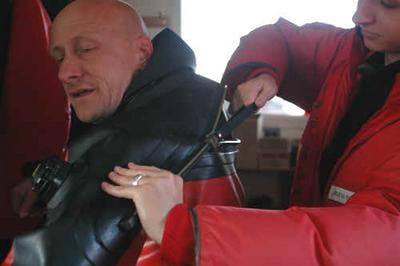
1: Zipping up the waterproof zipper on the dive suit

2: Putting on the air tank
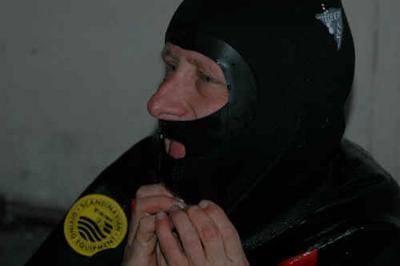
3: Putting on the waterproof (I hope) "gorilla hood"
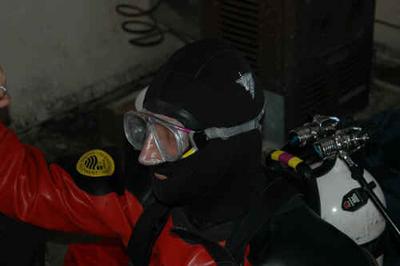
4: Mask on...getting close to getting wet!
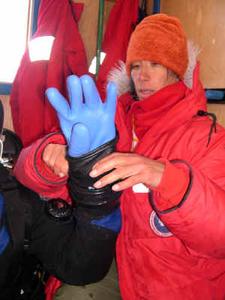
5: A tricky part - putting on the dive gloves properly
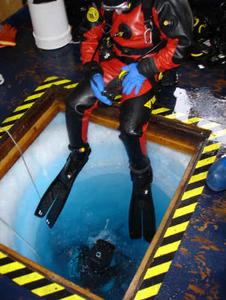
6: Ready to make the plunge!
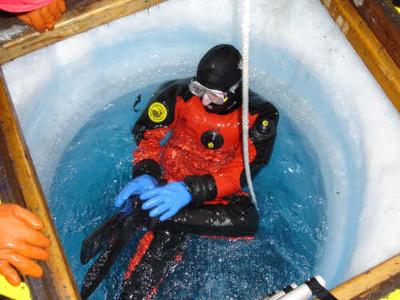
7: Taking the fins and tank off make it easier to get out of the hole after the dive.
Contact the TEA in the field at
.
If you cannot connect through your browser, copy the
TEA's e-mail address in the "To:" line of
your favorite e-mail package.
|
